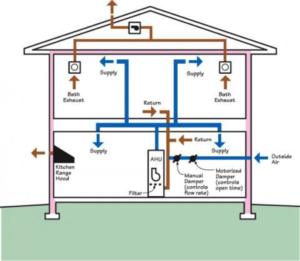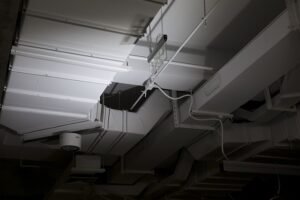A Treated Fresh Air (TFA) unit works in stages to deliver conditioned fresh air to a building. Here’s a breakdown of the working principle:
1. Intake:
- Outdoor air is drawn into the TFA unit through an intake duct, typically located on the roof or exterior wall of the building.

2. Filtration:
- The incoming air passes through air filters of varying grades. These filters remove dust, pollen, allergens, and other airborne contaminants, ensuring clean air enters the building.
3. Conditioning:
- Heating or cooling coils, along with heating/cooling elements, adjust the temperature of the fresh air. This brings the air to a desired temperature for comfortable occupancy within the building.
- Depending on the specific needs of the building, the TFA might also include:
- Dehumidification: If the incoming air is humid, a dehumidifier removes excess moisture to control humidity levels.
- Humidification: In dry climates, a humidifier might be used to add moisture to the air and maintain appropriate humidity levels.
4. Distribution:
- Once conditioned, the fresh air is ready for distribution throughout the building. A network of ducts carries the treated fresh air to various zones or rooms.

Key Points:
- Unlike a standard Air Handling Unit (AHU) that mixes fresh outdoor air with return air from the building, a TFA unit exclusively focuses on fresh air. This ensures a constant supply of clean, pre-treated outdoor air.
- The specific conditioning steps (heating, cooling, dehumidification, or humidification) will depend on the desired indoor environment and the outdoor climate conditions.
Here’s an analogy: You can imagine a TFA unit as a dedicated air steward for your building. It takes raw, outside air, cleans it up (filtration), adjusts the temperature to your liking (conditioning), and then delivers it throughout the building (distribution).
Looking to install a commercial HVAC System or Duct work in your Business Area?
Contact Vipul Ac to learn about our HVAC Service
Call +91 8000092000 Today.
